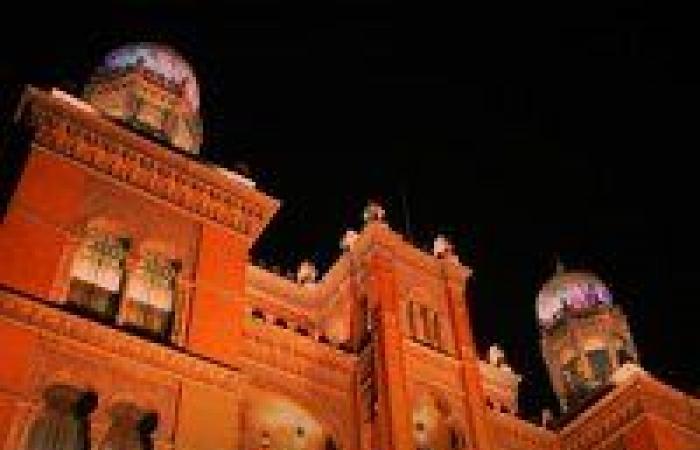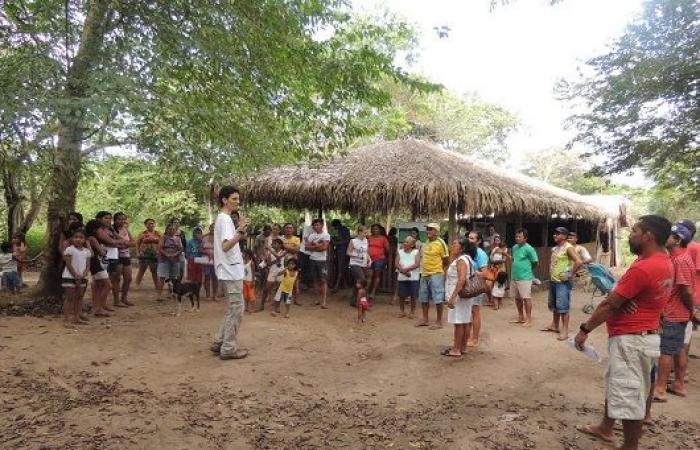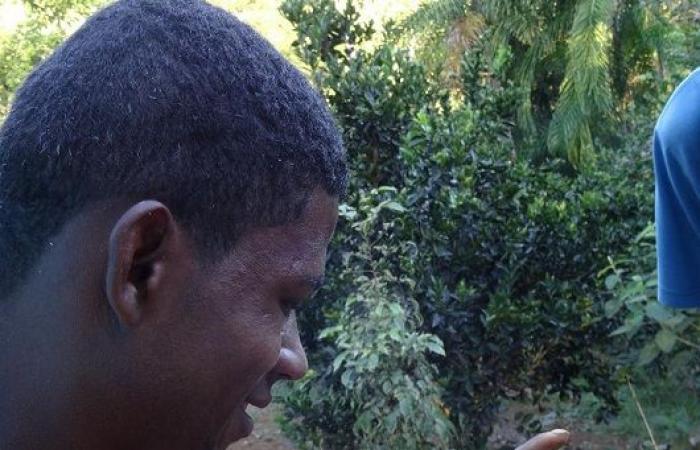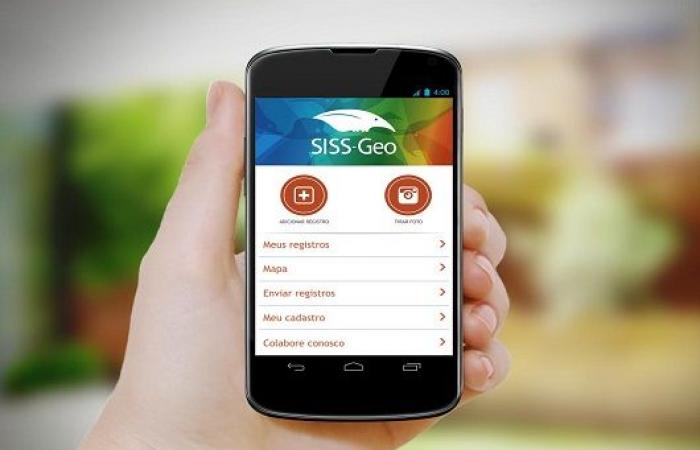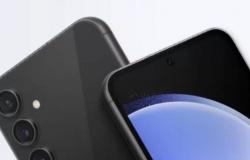The Wild Health Information Center and the Wild Health Information System (Siss-Geo) of Fiocruz, a platform developed for monitoring wild fauna and surveillance of zoonosis emergencies and biodiversity conservation and which is based on the participation of society and partner bodies, complete ten years this March. The event to celebrate this first decade will be held this Tuesday (26/3), from 8:30 am to 12:30 pm, in the auditorium of the Museu da Vida Fiocruz, in Rio de Janeiro, with online transmission via the Distribuidora VídeoSaúde channel. On the same day, the 10+ Collaborators of 2023 will be awarded, which annually recognizes the participation of society and health, environmental and other bodies and units in monitoring wild animals. Meet the 2023 winners in each category.
Siss-Geo coordinator, Marcia Chame, on fieldwork in the Tijuca Forest (photo: Siss-Geo)
Biologist and researcher Marcia Chame, coordinator of Siss-Geo, explains that the tool is developed based on citizen science, as it involves people participating in monitoring animals. For her, Siss-Geo allows society to understand the relationship between wild health and human health and thus rethink the way of living. This generates greater awareness for the conservation of biodiversity, which can bring improvements to health and modify the disease transmission process, and also knowledge about the impacts and environmental degradation that cause some diseases to reappear.
Marcia has just returned from the five-day workshop in Manaus, from March 11th to 15th, in which she and her team participated in training, capacity building and training of multipliers for the surveillance of epizootics and the use of Siss-Geo. “Actions like this are essential to strengthen epidemiological surveillance of diseases such as yellow fever, identified through epizootics in non-human primates, West Nile fever, detected through epizootics in equids and wild birds, and oropouche fever, through the surveillance of non-human primates, wild birds and xenarthras (sloths, anteaters and armadillos)”. She adds that the objective of the workshop was to increase the sensitivity of surveillance in relevant epidemiological events involving animals, using them as a sentinel strategy for detecting new outbreaks and to support risk analysis at a regional level and the adoption of safety measures. prevention and control.
Siss-Geo currently has a network of 12,844 employees, 174 specialists and 396 institutions from all Brazilian states and people from the most diverse profiles, originating from traditional, indigenous, rural and urban communities, public and private bodies, NGOs and volunteers. The winners are selected based on pre-established criteria that list the number of records sent to the system, divided into five categories: Volunteer Collaborators; Women Collaborators; Health, Environmental and Other Bodies Professionals; Health, Environment and Other Bodies Units/Teams; and Conservation Units. The award, which has been taking place since 2017, will also recognize the special Siss-Geo Ambassador category, for those who expand the use of the tool in their activities and territories and have accumulated more than a thousand records in the system over the years. Highlight will also be given to experts who support the taxonomic identification of animals.
Siss-Geo enables society to be a fundamental agent in monitoring the health of wild animals, in addition to collaborating with the surveillance of diseases whose infectious agents circulate between animals and humans – zoonoses, as well as other diseases. Using the Siss-Geo application, available free of charge for the simplest smartphone models, anyone can become a collaborator in monitoring fauna, photographing and reporting the physical conditions of animals and the environment, providing speed, efficiency and savings. of resources and data quality for decision making. The set of recorded data is processed by high-performance computing resources and, when it detects dead or sick animals, it generates automatic and real-time alerts to the managers of the responsible bodies. The records are audited and taxonomically validated and are used to generate favorability models for the occurrence of zoonoses in Brazilian municipalities.
Indigenous people receive training from researcher Eduardo Krempser to use the tool in the Amazon (photo: Siss-Geo)
Siss-Geo records are open and its database is available to health and environmental managers, researchers and institutions. The registration of live and healthy animals is important for identifying the factors that contribute or not to the conservation of biodiversity and quality of life. Siss-Geo can be used anywhere in the country and the observation location, date and time are automatically recorded by satellite. All information can be stored offline and when the employee enters the area with a telephone or Wi-Fi signal, the application informs that it has found the network and requests to send the data. Photographs can be selected in different sizes, so that they can be sent according to the available network quality and also without generating costs for the employee. The Siss-Geo app can be obtained on Google Play, the Apple Store and the Gov.br platform. The tool is a social technology certified by the Banco do Brasil Foundation.
The application and use of Siss-Geo by health professionals involved in the yellow fever prevention and control plan in southern Brazil made it possible to validate the virus transmission corridors and identify priority areas for vaccination. This drastically reduced human deaths and consolidated important data for assessing the impact of the disease on non-human primate species. Marcia Chame notes that “in Brazil, we learned that primates are the first to suffer, before humans, the effects of yellow fever. So, we started monitoring this indicator as an important warning, which helped us create forecast models projecting dispersion hypotheses and, with this, it was possible to support decisions about the vaccination process”.
On their travels around Brazil, spreading the use of the tool through workshops, Marcia and her team were in remote locations with very precarious conditions. From 2015 to 2017, the group developed work with 75 communities in the Tapajós-Arapiuns Extractive Reserve, in Pará – some of which can be reached after an eight-day trip by boat. A reality check occurred in the region when she and the team discovered that cell phones in people’s hands did not work. “We realized that the thick skin of people in that region doesn’t work on a cell phone screen. So it was necessary to redesign everything, changing the application buttons and making the screen more sensitive, so that people can use it. And the words are simple and easy to understand. This is also a work of digital inclusion.”
Origins
Marcia remembers that the embryo of what would become Siss-Geo emerged in 1997, when the episode of monkeys dying from yellow fever occurred in Serra da Capivara, in Piauí. People were vaccinated and the park closed, but only six months later the diagnostic results showed that the animals did not die from yellow fever. “We missed the opportunity to find out what the monkey disease was and whether it was an important issue for human health. Monitoring of animals, at the time, was done with the help of park guides, but with precariousness. From then on, a project was developed for six years and, during that time, it became clear that even people with low education can help monitor animals, as long as they have an accessible and easy-to-use tool,” she says.
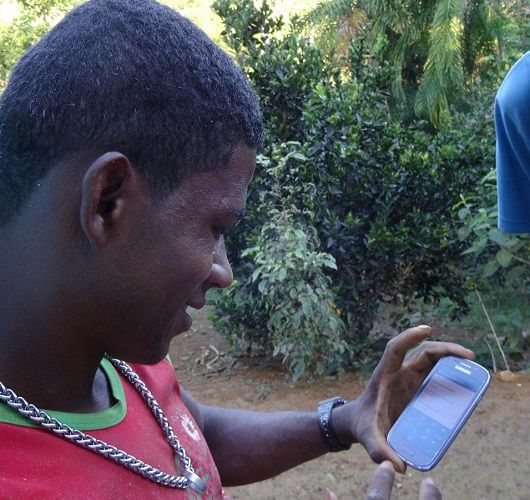
Boy learns to use the app in a community in southern Bahia (photo: Siss-Geo)
Later, in 2005, she was invited by the Ministry of the Environment to participate in the project to mainstream biodiversity conservation across different sectors. Within the health area, monitoring of wild health and its relationship with human health was proposed, which had already been done at Fiocruz since the times of Oswaldo Cruz and Carlos Chagas, although not in an integrated manner. At the time, which was extremely innovative, the objective was to create a tool that could also be used by society. “Today everything seems very obvious, but at that time it wasn’t, and there was a risk of it not working. Many said that using cell phones would not work, among other issues. The former presidents of Fiocruz Paulo Buss and Paulo Gadelha invested in the idea and gave us a lot of encouragement, in addition to receiving important support from the Ministry of the Environment and the World Bank”. Marcia recalls that a fundamental partnership for the project’s success was that established with the National Scientific Computing Laboratory (LNCC), which made the tool viable. According to her, the presidents of Fiocruz who followed, Nísia Trindade Lima and Mario Moreira, gave broad support to Siss-Geo.
After the launch of Siss-Geo, in 2014, the group began to promote workshops throughout Brazil, to take the tool to health agents, national park teams and society in general. When there was the yellow fever outbreak in 2017, in the Southeast Region, and the monkeys began to die, there was a great rapprochement with the General Coordination of Arboviruses of the Ministry of Health, giving a relevant boost to the tool.
“At that time, when the outbreak began to move towards the southern states, a large working group was created to model yellow fever, with the aim of knowing where yellow fever would reach and thus vaccinating people, in operation. jointly with the Health Departments of Paraná, Santa Catarina and Rio Grande do Sul. There was extensive training of health professionals and it was possible to find out where the monkeys were dying, validate the transmission corridors, with the methodology developed by Sucen/ SP, and identify risk areas, giving states time to vaccinate people, as we knew in which locations the virus would arrive in the following months. The result was a reduction of more than 90% in the number of human deaths from yellow fever”, highlights the researcher. For her, that was the moment when the effectiveness of Siss-Geo was proven.
The success of the tool led to the expansion of Siss-Geo throughout Brazil. And in 2020, when a new variant of the virus observed in Tocantins arrived in Goiás and the Federal District, people were vaccinated and the number of human deaths fell immensely. The work was also carried out in the Northeast and is now reaching the Amazon states, where people were already vaccinated but where there are gaps due to lack of notification about monkeys. Due to the good results, SISS-Geo began to be used in the surveillance of other viruses, such as Nile fever.
What’s next
Marcia says that there will be new features in the tool soon. “Now we are developing the SUS module, which is being used by health professionals, zoonosis centers and bodies that work in surveillance. The SUS module allows the manager to receive all alerts and use the database. This will be an important milestone in health surveillance in Brazil, giving more accuracy to prediction models”, says Marcia, who has been at Fiocruz since 1980 and is the only one to have been part of Siss-Geo since the tool’s inception.
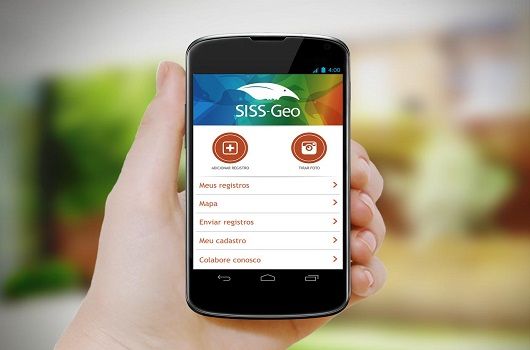
The Siss-Geo app can be obtained on Google Play, the Apple Store and the Gov.br platform (photo: Siss-Geo)
The researcher states that a new challenge, together with the Ministry of Health, will be to integrate urban zoonoses into Siss-Geo, that is, diseases of cats and dogs. “It will be a big challenge, since Brazil has millions of domestic animals. We will need to raise awareness so that they can collaborate, within the concept of citizen science.”
Siss-Geo is managed by a lean team. In total, there are 15 professionals, from the areas of biology, social science, communication, geography and computer science. Among the external partners are, in addition to the general coordination of Arboviruses and Zoonoses of the MS, Embrapa Pantanal, the State University of Mato Grosso, the Federal University of Viçosa, the Caminhos da Mata Atlântica Institute and Imperial College, London.
Tags: Event celebrates ten years Fiocruz platform monitors zoonoses
--
